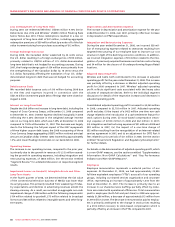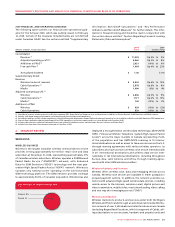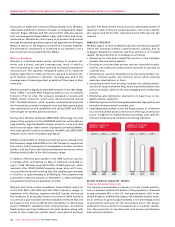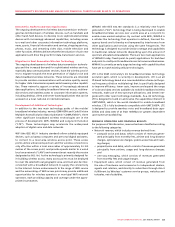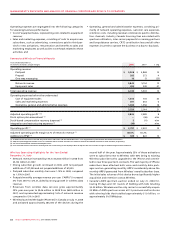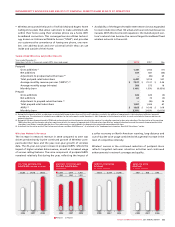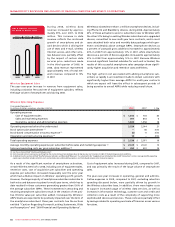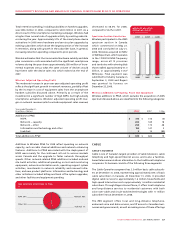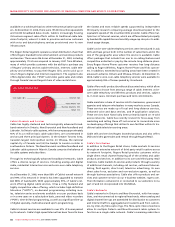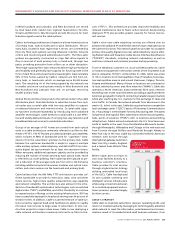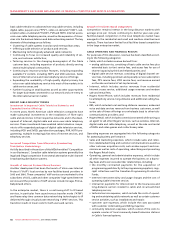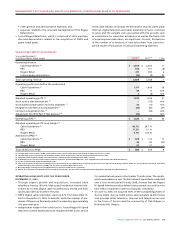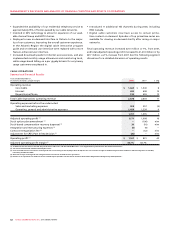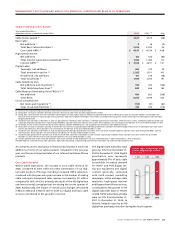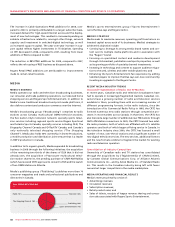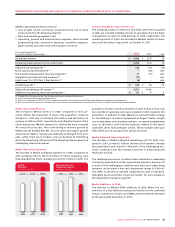Rogers 2008 Annual Report Download - page 44
Download and view the complete annual report
Please find page 44 of the 2008 Rogers annual report below. You can navigate through the pages in the report by either clicking on the pages listed below, or by using the keyword search tool below to find specific information within the annual report.
40 ROGERS COMMUNICATIONS INC. 2008 ANNUAL REPORT
MANAGEMENT’S DISCUSSION AND ANALYSIS OF FINANCIAL CONDITION AND RESULTS OF OPERATIONS
basic cable television to advanced two-way cable services, including
digital cable, pay-per-view (“PPV”), video-on-demand (“VOD”), sub-
scription video-on-demand (“SVOD”), PVR and HDTV, Internet access,
voice-over-cable telephony service, as well as the expansion of its ser-
vices into the business telecom and data networking market. The key
elements of the strategy are as follows:
• Clusteringofcablesystemsinandaroundmetropolitanareas;
• Offeringawideselectionofproductsandservices;
• Maintainingtechnologicallyadvancedcablenetworks;
• Continuingtofocusonincreasedqualityandreliabilityofser-
vice, and customer satisfaction;
• Tailoring services to the changing demographic of the Cable
customer base, including expansion of products directly serving
several multicultural communities;
• Continuingtoimproveproductfeatures,includingexpanding
available TV content, including HDTV and VOD selection, faster
tiers of Internet service and new telephony service offerings;
• Expandingtheavailabilityofhigh-qualitydigitalprimaryline
voice-over-cable telephony service into most of the markets in its
cable service areas; and
• Furtherfocusingonsmallbusinessaswellasotheropportunities
for larger businesses connected to our network and a re-entry to
the international carrier market.
RECENT CABLE INDUSTRY TRENDS
Investment in Improved Cable Television Networks and
Expanded Service Offerings
In recent years, North American cable television companies have
made substantial investments in the installation of fibre-optic
cable and electronics in their respective networks and in the devel-
opment of Internet, digital cable and voice-over-cable telephony
services. These investments have enabled cable television compa-
nies to offer expanded packages of digital cable television services,
including VOD and SVOD, pay television packages, PVR, HDTV pro-
gramming, multiple increasingly fast tiers of Internet services, and
telephony services.
Increased Competition from Alternative Broadcasting
Distribution Undertakings
As fully described in the section of this MD&A entitled “Competition
in our Businesses”, Canadian cable television systems generally face
legal and illegal competition from several alternative multi-channel
broadcasting distribution systems.
Growth of Internet Protocol-Based Services
Another development has been the launch of Voice-over-Internet
Protocol (“VoIP”) local services by non-facilities-based providers in
2005 and 2006. These companies’ VoIP services are marketed to the
subscribers of ILEC, cable and other companies’ high-speed Internet
services and the providers of VoIP services include Vonage, Primus,
Babytel and others.
In the enterprise market, there is a continuing shift to IP-based
services, in particular from asynchronous transfer mode (“ATM”)
and frame relay (two common data networking technologies) to IP
delivered through virtual private networking (“VPN”) services. This
transition results in lower costs for both users and carriers.
Growth of Facilities-Based Competitors
Competition remains intense in the long-distance markets with
average price per minute continuing to decline year-over-year.
Facilities-based competitors in the local telephone market have
emerged in the residential and small and medium-sized business
markets. There has been limited local facilities-based competition
in the large enterprise market.
CABLE OPERATING AND FINANCIAL RESULTS
For purposes of this discussion, revenue has been classified accord-
ing to the following categories:
• Cable,whichincludesrevenuederivedfrom:
• analogcableservice,consistingofbasiccableservicefeesplus
extended basic (or tier) service fees, and access fees for use of
channel capacity by third and related parties; and
• digitalcableservicerevenue,consistingofdigitalchannelser-
vice fees, including premium and specialty service subscription
fees, PPV service fees, VOD service fees, and revenue earned
on the sale and rental of set-top terminals;
• Internet, which includes service revenues from residential
Internet access service, additional usage revenues and modem
sale and rental fees;
• RogersHomePhone,whichincludesrevenuesfromresidential
local telephony service, long-distance and additional calling fea-
tures;
• RBS,whichincludeslocalandlong-distancerevenues,enhanced
voice and data services revenue from business customers, as well
as the sale of these offerings on a wholesale basis to other tele-
communications providers; and
• RogersRetail,whichincludescommissionsearnedwhileactingas
an agent to sell other Rogers’ services, such as wireless, Internet,
digital cable and cable telephony, as well as the sale and rental
of DVDs and video games and confectionary sales.
Operating expenses are segregated into the following categories
for assessing business performance:
• Salesandmarketingexpenses,whichinclude salesandreten-
tion-related advertising and customer communications as well as
other customer acquisition costs, such as sales support and com-
missions as well as costs of operating, advertising and promoting
the Rogers Retail chain;
• Operating,generalandadministrativeexpenses,whichinclude
all other expenses incurred to operate the business on a day-to-
day basis and to service subscriber relationships, including:
• the monthly contracted payments for the acquisition of
programming paid directly to the programming suppliers, copy-
right collectives and the Canadian Programming Production
Funds;
• Internetinterconnectivityandusagechargesandthecostof
operating Cable’s Internet service;
• intercarrierpaymentsforinterconnecttothelocalaccessand
long-distance carriers related to cable and circuit-switched
telephony service;
• technicalserviceexpenses,whichincludethecostsofoperat-
ing and maintaining cable networks as well as certain customer
service activities, such as installations and repair;
• customer careexpenses, which includethe costsassociated
with customer order-taking and billing inquiries;
• communitytelevisionexpenses,whichconsistofthecoststo
operate a series of local community-based television stations
in Cable’s licenced systems;


